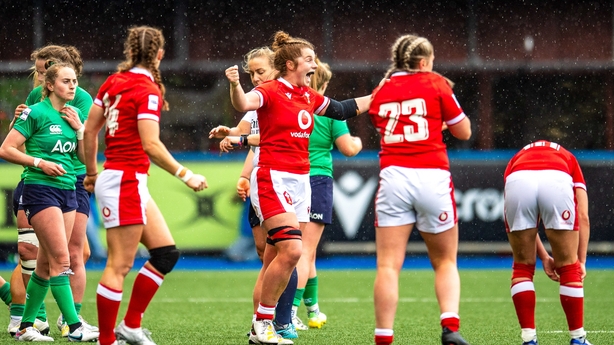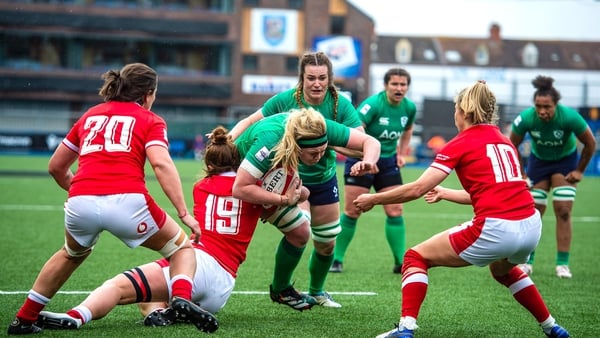Ireland were disappointingly blown away by Wales last weekend in the opening round of the Women's Six Nations.
To go in at half-time 26-0 behind, to a team that Ireland traditionally had the beating of, shows the gulf that’s beginning to appear with the progressive professionalism in the game.
France, and England in particular, have been miles ahead of their Celtic counterparts for the last number of years. Maybe Wales are now joining that group of elites and separating themselves from the rest of the pack.
The Welsh union has been a shambles when it comes to the male side of the game, which hit rock bottom throughout this year’s Six Nations tournament. However, the foresight and investment that has gone into their women’s game shows progression. The IRFU have been slower to make the same shift to professionalism.
Irish rugby has been more reactive in terms of contracting non 7s players in the IRFU system, although there is some structure put in place now to catch up. On the outside, those agreements look as though things will progress in the same way that the Welsh team have, but the structures below those weak contracts won’t lend themselves to rapid progression.
A lack of funding in the club game, with the inter-provincials deemed to be a short-term fix, won’t get these players up to the standard of international rugby and the gap between the elite and the non-elite is continuing to grow.
Ireland were blown away by the stronger and heavier Welsh pack
This was seen in the match on Saturday afternoon at Cardiff Arms Park. Ireland went to Wales two years ago and won 45-0 when both teams were fully amateur. Wales then started the process of contracting players and beat Ireland in Dublin last year, although Ireland were two tries to the good at half-time, so it was a competitive game.
Last Saturday was far from a competitive fixture. Ireland were blown away by the stronger and heavier Welsh pack, with more experience in their scrum and tight exchanges.
The structure and fallout in the last couple of years in the female game in Ireland has led to losing some of the more experienced players from the squad. Whether it has been due to political decision making, low ball contract offers or dual 7s and 15s contracts reducing player availability, Ireland went to Cardiff with an inexperienced team and showed all the signs of it.
There were at least a handful of noticeable absentees from the team that lined out against Wales last year.
This isn’t the players' fault. If you go from an under-funded AIL league, where some of the players have opted to play abroad for better standards and conditions, to inter provincials and combined provinces games in the short term, you’re going to feel the effects of a higher standard at international level.
The whole Welsh team is playing in the English Premier 15s, up against international standard opposition with the influx of American and Canadian internationals, among others. Just nine of the Irish team play their rugby in England.
In the AIL you’re still getting teams folding due to the inability to fund their game, a lack of structure from above and a lower standard of play as a result.
Aside from this, Wales looked like they had more time together. They have more time to dedicate to their strength and conditioning, more time to spend on their playing systems, and it showed throughout the game last Saturday afternoon.

It wasn’t just the fact that Wales had a weight advantage in the pack, their passing was slick, their set piece was dominant. Ireland chose to avoid setpieces in the first half, maybe because of a tough wind making it difficult to kick, but that didn’t stop Wales from kicking to touch when the roles were reversed in the second half.
Ireland started well with nice interplay and effective deep passes behind their forward pods to move the play but it didn’t take long for Wales to strangle their go-forward ball and put a stop to any cohesion that we saw in the opening exchanges. At the end of the day, rugby is a simple sport. If you can dominate the physical stakes and go forward, the game becomes a whole lot easier.
Wales were the more physical side and their skills and attacking structures looked far superior as a result.
That’s not to say things are all bad in Ireland. Contracts have started, and that’s only the beginning. One would hope that they will progress close to the speed of contract progressions abroad, however, the starting point was already lower than their counterparts elsewhere. While progress is being made, it still needs more investment.
Irish men’s rugby was also a slow starter in comparison to their English and European colleagues and look at where they are today. The men’s game wasn’t without its fair share of poor performances and lack of standards until the mid to late noughties. Contracts were slow at the start as well and many sought pastures new in the flourishing game in England.
However, the AIL was strong, stronger than it is now and it was the lifeblood for up-and-coming talent. The men’s game was feeding itself with internationals lining out weekly in highly competitive battles.
There’s also a schools structure in the men’s game that has been in place long before any talk of the professional game. That too has become more serious in time but the same structure isn’t afforded to the girls game.
Ireland are finally on the scoreboard as the TMO intervenes to allow Nichola Fryday's try.
— RTÉ Rugby (@RTErugby) March 25, 2023
📺 Watch live now on RTÉ2/RTÉ Player.
💻 https://t.co/Go8eAdapDV pic.twitter.com/m19NPVPygz
Contracting young Irish players that are more willing to earn low wages for their international progress will certainly help Ireland’s progress, and with no World Cup to look at, there’s time to really establish a playing group to go on to the next tournament.
Yet, you have to think that Ireland are missing a trick. If Irish rugby can fund everything below the professional game, the international game will be better for it.
There will always be a chicken and an egg scenario here. There will be doubts over whether the game should be funded when participation isn’t huge and the female game isn’t resourcing itself. However, if you take that approach, you’ll never get there.
The investment needs to go into the game before it can be self-sufficient. It won’t work the other way around. The investment needs to go in at all levels, improving the conditions that girls at all levels play at and the support that they can get to improve as a player but also to be comfortable as a person.
Some conditions in the past have been nothing short of awful and it won’t lend itself to continuity with participation.
The female game needs to be more attractive for current and future members so that the top level of the game can thrive going forward.


